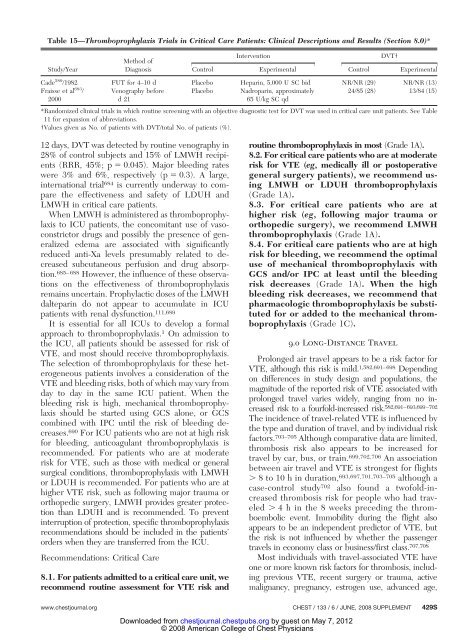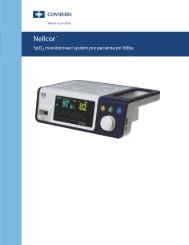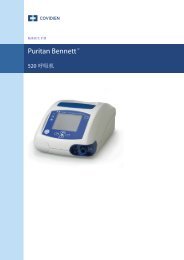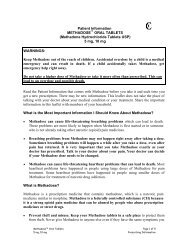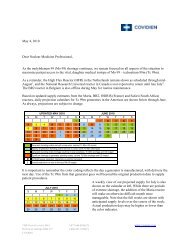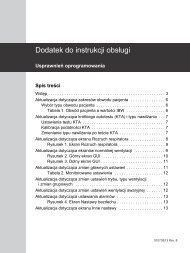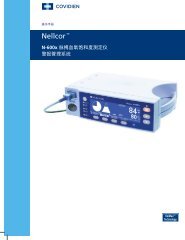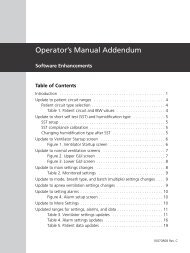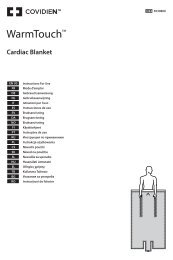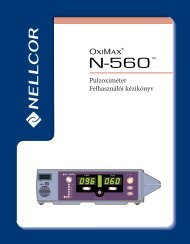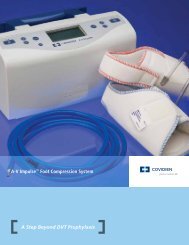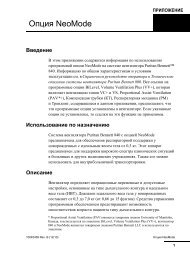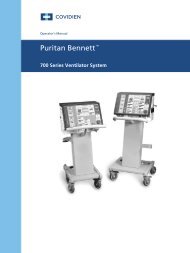Prevention of Venous Thromboembolism - Covidien
Prevention of Venous Thromboembolism - Covidien
Prevention of Venous Thromboembolism - Covidien
You also want an ePaper? Increase the reach of your titles
YUMPU automatically turns print PDFs into web optimized ePapers that Google loves.
Table 15—Thromboprophylaxis Trials in Critical Care Patients: Clinical Descriptions and Results (Section 8.0)*<br />
Study/Year<br />
Method <strong>of</strong><br />
Diagnosis<br />
12 days, DVT was detected by routine venography in<br />
28% <strong>of</strong> control subjects and 15% <strong>of</strong> LMWH recipients<br />
(RRR, 45%; p � 0.045). Major bleeding rates<br />
were 3% and 6%, respectively (p � 0.3). A large,<br />
international trial 684 is currently underway to compare<br />
the effectiveness and safety <strong>of</strong> LDUH and<br />
LMWH in critical care patients.<br />
When LMWH is administered as thromboprophylaxis<br />
to ICU patients, the concomitant use <strong>of</strong> vasoconstrictor<br />
drugs and possibly the presence <strong>of</strong> generalized<br />
edema are associated with significantly<br />
reduced anti-Xa levels presumably related to decreased<br />
subcutaneous perfusion and drug absorption.<br />
685–688 However, the influence <strong>of</strong> these observations<br />
on the effectiveness <strong>of</strong> thromboprophylaxis<br />
remains uncertain. Prophylactic doses <strong>of</strong> the LMWH<br />
dalteparin do not appear to accumulate in ICU<br />
patients with renal dysfunction. 111,689<br />
It is essential for all ICUs to develop a formal<br />
approach to thromboprophylaxis. 1 On admission to<br />
the ICU, all patients should be assessed for risk <strong>of</strong><br />
VTE, and most should receive thromboprophylaxis.<br />
The selection <strong>of</strong> thromboprophylaxis for these heterogeneous<br />
patients involves a consideration <strong>of</strong> the<br />
VTE and bleeding risks, both <strong>of</strong> which may vary from<br />
day to day in the same ICU patient. When the<br />
bleeding risk is high, mechanical thromboprophylaxis<br />
should be started using GCS alone, or GCS<br />
combined with IPC until the risk <strong>of</strong> bleeding decreases.<br />
690 For ICU patients who are not at high risk<br />
for bleeding, anticoagulant thromboprophylaxis is<br />
recommended. For patients who are at moderate<br />
risk for VTE, such as those with medical or general<br />
surgical conditions, thromboprophylaxis with LMWH<br />
or LDUH is recommended. For patients who are at<br />
higher VTE risk, such as following major trauma or<br />
orthopedic surgery, LMWH provides greater protection<br />
than LDUH and is recommended. To prevent<br />
interruption <strong>of</strong> protection, specific thromboprophylaxis<br />
recommendations should be included in the patients’<br />
orders when they are transferred from the ICU.<br />
Recommendations: Critical Care<br />
8.1. For patients admitted to a critical care unit, we<br />
recommend routine assessment for VTE risk and<br />
Intervention DVT†<br />
Control Experimental Control Experimental<br />
Cade 589 /1982 FUT for 4–10 d Placebo Heparin, 5,000 U SC bid NR/NR (29) NR/NR (13)<br />
Fraisse et al 683 / Venography before Placebo Nadroparin, approximately<br />
24/85 (28) 13/84 (15)<br />
2000<br />
d21<br />
65 U/kg SC qd<br />
*Randomized clinical trials in which routine screening with an objective diagnostic test for DVT was used in critical care unit patients. See Table<br />
11 for expansion <strong>of</strong> abbreviations.<br />
†Values given as No. <strong>of</strong> patients with DVT/total No. <strong>of</strong> patients (%).<br />
routine thromboprophylaxis in most (Grade 1A).<br />
8.2. For critical care patients who are at moderate<br />
risk for VTE (eg, medically ill or postoperative<br />
general surgery patients), we recommend using<br />
LMWH or LDUH thromboprophylaxis<br />
(Grade 1A).<br />
8.3. For critical care patients who are at<br />
higher risk (eg, following major trauma or<br />
orthopedic surgery), we recommend LMWH<br />
thromboprophylaxis (Grade 1A).<br />
8.4. For critical care patients who are at high<br />
risk for bleeding, we recommend the optimal<br />
use <strong>of</strong> mechanical thromboprophylaxis with<br />
GCS and/or IPC at least until the bleeding<br />
risk decreases (Grade 1A). When the high<br />
bleeding risk decreases, we recommend that<br />
pharmacologic thromboprophylaxis be substituted<br />
for or added to the mechanical thromboprophylaxis<br />
(Grade 1C).<br />
9.0 Long-Distance Travel<br />
Prolonged air travel appears to be a risk factor for<br />
VTE, although this risk is mild. 1,582,691–698 Depending<br />
on differences in study design and populations, the<br />
magnitude <strong>of</strong> the reported risk <strong>of</strong> VTE associated with<br />
prolonged travel varies widely, ranging from no increased<br />
risk to a fourfold-increased risk. 582,691–693,699–702<br />
The incidence <strong>of</strong> travel-related VTE is influenced by<br />
the type and duration <strong>of</strong> travel, and by individual risk<br />
factors. 703–705 Although comparative data are limited,<br />
thrombosis risk also appears to be increased for<br />
travel by car, bus, or train. 699,702,706 An association<br />
between air travel and VTE is strongest for flights<br />
� 8 to 10 h in duration, 693,697,701,703–705 although a<br />
case-control study 702 also found a tw<strong>of</strong>old-increased<br />
thrombosis risk for people who had traveled<br />
� 4 h in the 8 weeks preceding the thromboembolic<br />
event. Immobility during the flight also<br />
appears to be an independent predictor <strong>of</strong> VTE, but<br />
the risk is not influenced by whether the passenger<br />
travels in economy class or business/first class. 707,708<br />
Most individuals with travel-associated VTE have<br />
one or more known risk factors for thrombosis, including<br />
previous VTE, recent surgery or trauma, active<br />
malignancy, pregnancy, estrogen use, advanced age,<br />
www.chestjournal.org CHEST / 133 /6/JUNE, 2008 SUPPLEMENT 429S<br />
Downloaded from<br />
chestjournal.chestpubs.org by guest on May 7, 2012<br />
© 2008 American College <strong>of</strong> Chest Physicians


